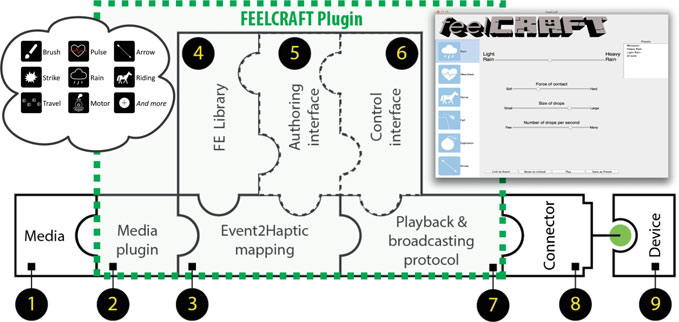FeelCraft

Tool Summary
| Metadata | |
|---|---|
| Release Yearⓘ The year a tool was first publicly released or discussed in an academic paper. | 2014 |
| Platformⓘ The OS or software framework needed to run the tool. | Java, Python |
| Availabilityⓘ If the tool can be obtained by the public. | Unavailable |
| Licenseⓘ Tye type of license applied to the tool. | Unknown |
| Venueⓘ The venue(s) for publications. | ACM UISTAsiaHaptics |
| Intended Use Caseⓘ The primary purposes for which the tool was developed. | Collaboration, Haptic Augmentation |
| Hardware Information | |
|---|---|
| Categoryⓘ The general types of haptic output devices controlled by the tool. | Vibrotactile |
| Abstractionⓘ How broad the type of hardware support is for a tool.
| Consumer |
| Device Namesⓘ The hardware supported by the tool. This may be incomplete. | Vybe Haptic Gaming Pad |
| Device Templateⓘ Whether support can be easily extended to new types of devices. | No |
| Body Positionⓘ Parts of the body where stimuli are felt, if the tool explicitly shows this. | N/A |
| Interaction Information | |
|---|---|
| Driving Featureⓘ If haptic content is controlled over time, by other actions, or both. | Action |
| Effect Localizationⓘ How the desired location of stimuli is mapped to the device.
| Device-centric |
| Non-Haptic Mediaⓘ Support for non-haptic media in the workspace, even if just to aid in manual synchronization. | None |
| Iterative Playbackⓘ If haptic effects can be played back from the tool to aid in the design process. | Yes |
| Design Approachesⓘ Broadly, the methods available to create a desired effect.
| Direct, Library, Description |
| UI Metaphorsⓘ Common UI metaphors that define how a user interacts with a tool.
| Generic Menu |
| Storageⓘ How data is stored for import/export or internally to the software. | Custom JSON |
| Connectivityⓘ How the tool can be extended to support new data, devices, and software. | API |
Additional Information
FeelCraft is a technical architecture where libraries of haptic effects (feel effects) are triggered by events in pre-existing media applications through the use of the FeelCraft plugin. The implemented example connects to the event system of a Minecraft server. Families of feel effects are expressed in software and controllable through sets of parmeters that are made available to users through a menu interface. In this example, as in-game events occur (e.g., it begins to rain), an associated feel effect with the selected parameters will be displayed to the person playing the game.
For more information on FeelCraft, consult the UIST’14 demo and the relevant chapter of Haptic Interaction.